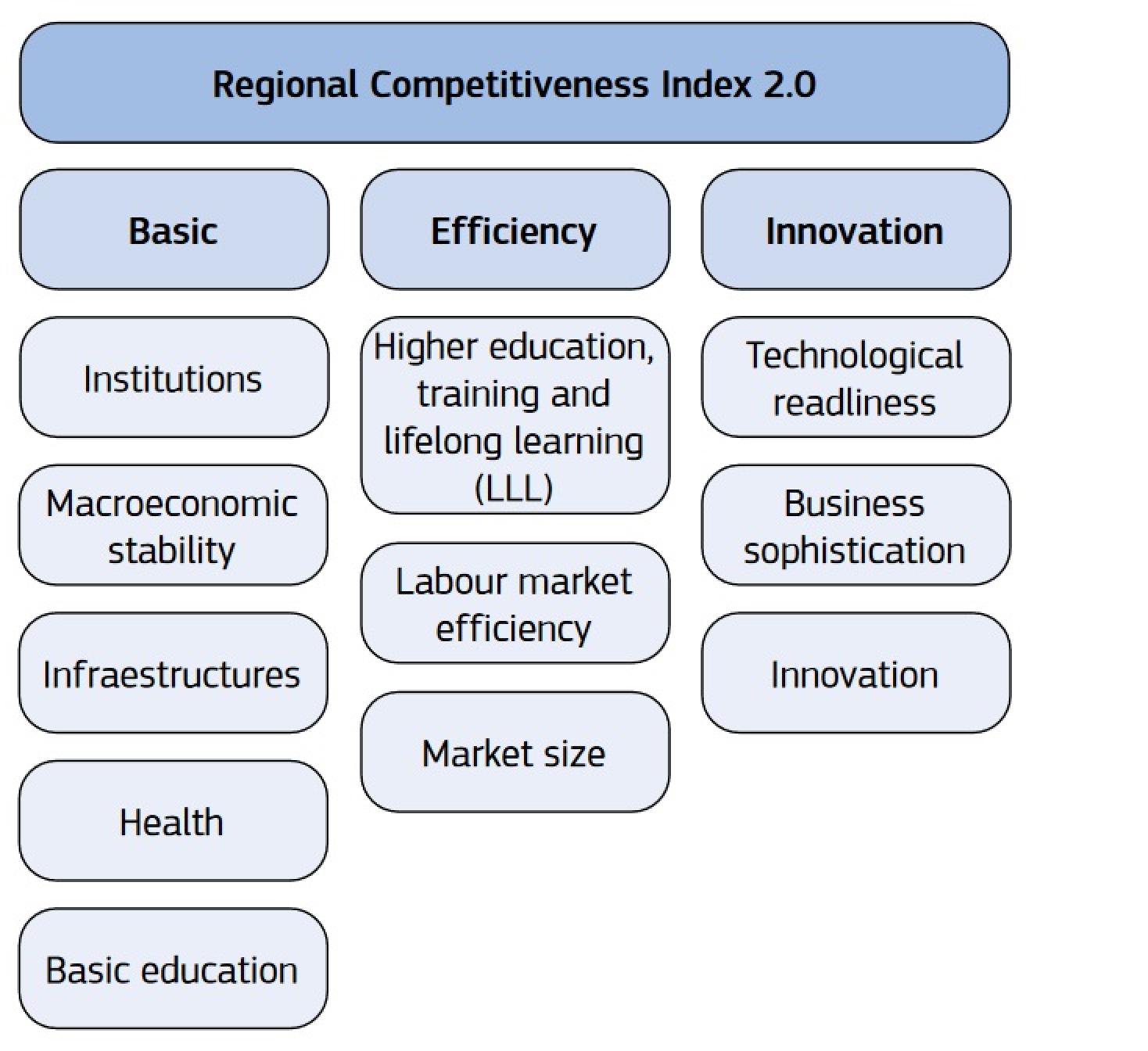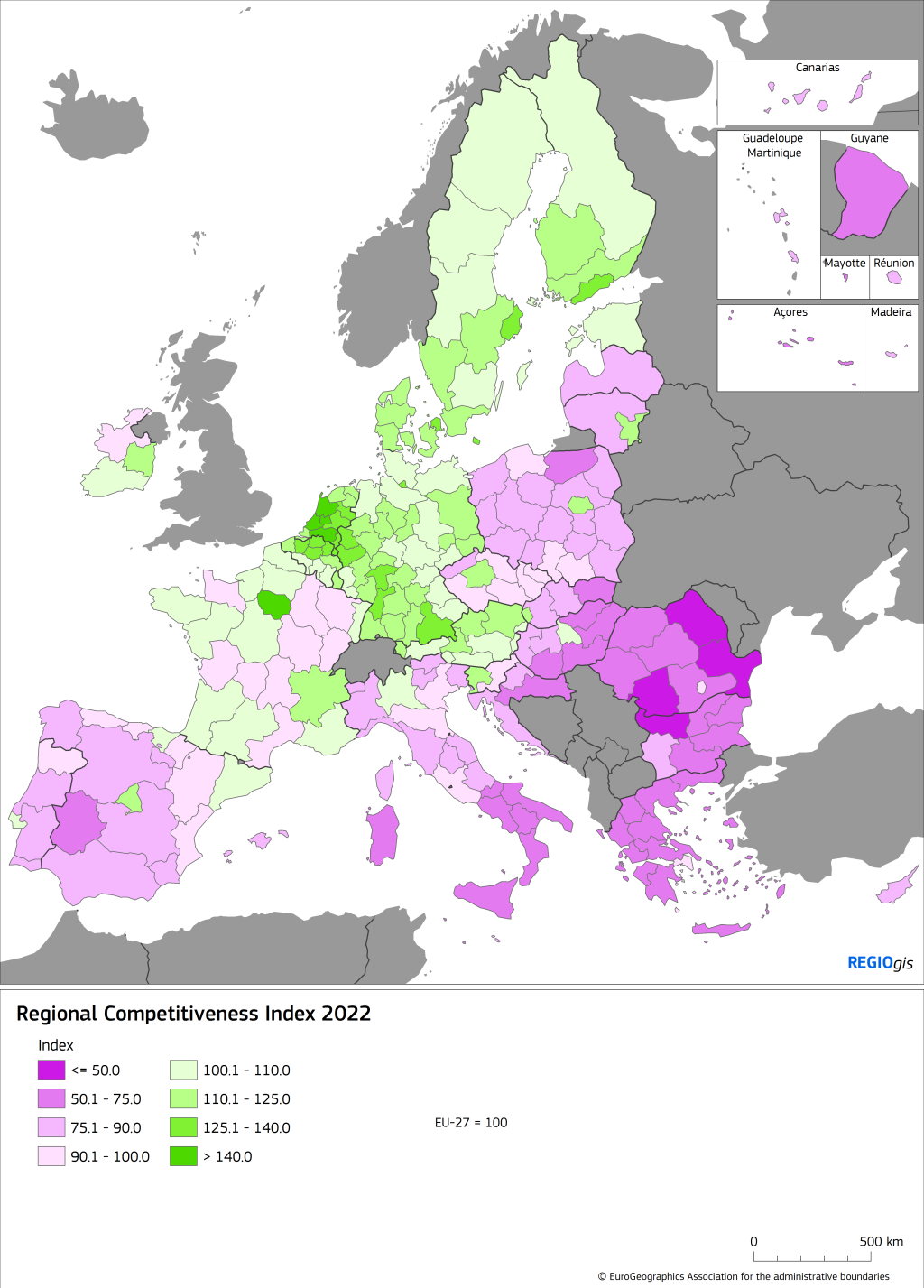About
CC-COIN is collaborating with the Directorate General for Regional and Urban Policy (DG REGIO) on the following work streams.
Regional Competitiveness Index
Since 2010, the EU Regional Competitiveness Index (RCI) has been measuring the major factors of competitiveness for all the NUTS-2 level regions across the European Union. The Index measures, with a rich set of indicators, the ability of a region to offer an attractive environment for firms and residents to live and work. Starting from the framework developed by the WEF for their Global Competitiveness Index (GCI), the RCI adapts this framework and extends it to the regional context in the EU, with the aim of capturing the underlying factors that support a region’s long-term economic development.

“Regional competitiveness is the ability of a region to offer an attractive and sustainable environment for firms and residents to live and work.”
The RCI is composed of three sub-indices – Basic, Efficiency, and Innovation – and of 11 pillars that describe the different aspects of competitiveness:
- The Basic sub-index refers to the key basic drivers of all types of economies. It identifies the main issues that are necessary to develop regional competitiveness, and includes five pillars: Institutions, Macroeconomic stability, Infrastructures, Health, and Basic education.
- The Efficiency sub-index includes three pillars: Higher education, training and lifelong learning, Labour market efficiency, and Market size. As a regional economy develops, these aspects are related to a more skilled labour force and a more efficient labour market.
- The Innovation sub-index includes the three pillars that are the drivers of improvement at the most advanced stage of economic development: Technological readiness, Business sophistication, and Innovation.
EU Regional Competitiveness Index 2.0 - 2022 edition

Regional Social Progress Index
Since its first edition in 2016, the EU Social Progress Index (EU-SPI) captures the societal development and quality of life at the regional level going beyond the Gross Domestic Product. This index measures social progress in European regions, at the NUTS2 level, using comparable social and environmental indicators, purposefully excluding economic aspects. The EU-SPI It builds on the definition of social progress in the global Social Progress Index, published yearly at the country level by the Social Progress Imperative:
“Social progress is the capacity of a society to meet the basic human needs of its citizens, establish the building blocks that allow peoples and communities to enhance and sustain the quality of their lives, and create the conditions for all individuals to reach their full potential.”

The definition refers to three broad dimensions of social progress: Basic Human Needs, the Foundations of Well-being, and Opportunity. Each dimension is further broken down into four underlying components:
- Nutrition and basic medical care, Water and sanitation, Shelter, and Personal security, in the Basic Human Needs dimension;
- Access to basic knowledge, Access to information and communication technologies (ICT), Health and wellness, and Environmental quality, included in the Foundations of Well-being dimension;
- Personal rights, personal freedom and choice, Tolerance and inclusion, and Access to advanced education, in the Opportunity dimension.
Regional Gender Equality Monitor
While there are several measures of gender equality at country level, only the EU Regional Gender Equality Monitor, joint work of DG JRC and DG REGIO, captures regional differences in Europe. Gender equality is one of the fundamental values of the European Union and the European Pillar of Social Rights establishes it as one of its key principles. This regional gender equality monitor consists of two composite indices that address two specific and complementary aspects of this multifaceted phenomenon. Viewing together the two indices facilitates the understanding of where women are at disadvantage and where they are performing well across the different regions and between the Member States:
- The Female Disadvantage Index (FemDI) assesses the female disadvantage by measuring regional differences when females are doing worse than males.
- The Female Achievement Index (FemAI) measures the female level of achievement compared to the best regional performance.

The regional monitor for the EU builds on seven domains:
- Work and Money
- Knowledge
- Time
- Power
- Health
- Safety, Security & Trust
- Quality of Life
Latest knowledge from this Project
JRC - Joint Research Centre
More information
| Originally Published | Last Updated | 10 Jul 2023 | 17 Nov 2023 |
| Knowledge service | Metadata | Composite Indicators |
| Related organisation(s) | JRC - Joint Research Centre |
Share this page
